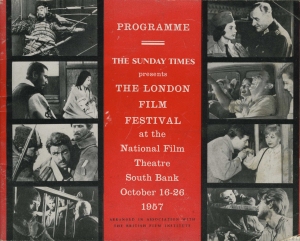Olivia explains the process of selecting items for the display…
The BFI London Film Festival was first conceived in 1953. After witnessing the success of other European film festivals, a group of British film critics decided it was time for London to produce one of its own. Based at the National Film Theatre (now the lovely BFI Southbank), the first event was sponsored by The Sunday Times and aimed to be a ‘festival of festivals’, featuring the best of internationally-regarded film. Now in its 57th year, it continues to deliver a strong British and international programme, drawing in critics, industry professionals and audiences from around the world.
The central object of our mini display is the programme for the inaugural festival in 1957, only recently acquired by the BillDouglasCinemaMuseum by our principal donor Peter Jewell. The striking red cover displays eight stills from films featured in the festival.
There are only 15 films listed inside the programme and on the separate programme list. Titled as “An International Programme”, all are by international filmmakers. Though the selection may seem small, it has proven to be extremely well chosen with several still being known as cinema classics today, including The Nights of Cabiria, The Seventh Seal and Throne of Blood. We have included two artefacts from films featured in 1957: a Throne of Blood promotional poster and the screenplay of The Seventh Seal. Both films are challenging pieces of world cinema that helped open up the work of Akira Kurosawa and Ingmar Bergman to British audiences, as the festival continues to do for other international filmmakers.
In choosing our remaining objects, we sought to represent the scope and personality of the festival across the years. From the flashy, pink-purple plastic cover of the 5th Festival programme in 1961 (3), to a bold Union Jack on the 1965 programme (5), the festival has captured the zeitgeist across the decades. Interestingly, the two most recent programmes in 2012 and 2013 are far less stylised, displaying their contents as a magazine would. This change may be explained by the increased size of the festival (from 15 films in 1957 to 235 feature films today) requiring programmes to be designed for functionality, rather than as objects of impressive design.
Alongside the programmes, we have also included the awards programme from 1998 LFF and the ticket for the ceremony. These items helped give a sense of the festival as an event, rather than a disconnected series of film screenings. Though previously awarded in a ceremony alongside the Closing Gala, a standalone ceremony was launched in 2009.
Jess explains the process of putting the display together…
When thinking about arranging the BFI exhibit, Olivia and I focused on presenting a range of materials that were colourful and dynamic. Thankfully these were fairly easy to find, since the majority of the items were from the late 50s and early 60s and carried a typically bold design. In particular, our centrepiece item – a programme from the first ever BFI festival in 1956 – was printed in an eye-catching red with futuristic typeface.
Once our central item was in place, we started to design the case around it. We collected items of different heights and shapes, from a small screening ticket, to pull-outs, to a triangular shaped awards programme. We were limited by the size of the case itself, which made overcrowding a problem. Because of this, we ended up using just one or two items to match our areas of research.
When it came to presenting our information, we wanted to convey it in a straightforward way, with an eye to matching the exhibits. For example, our research on the beginnings of the London Film Festival was placed next to our centrepiece, the first ever programme.







